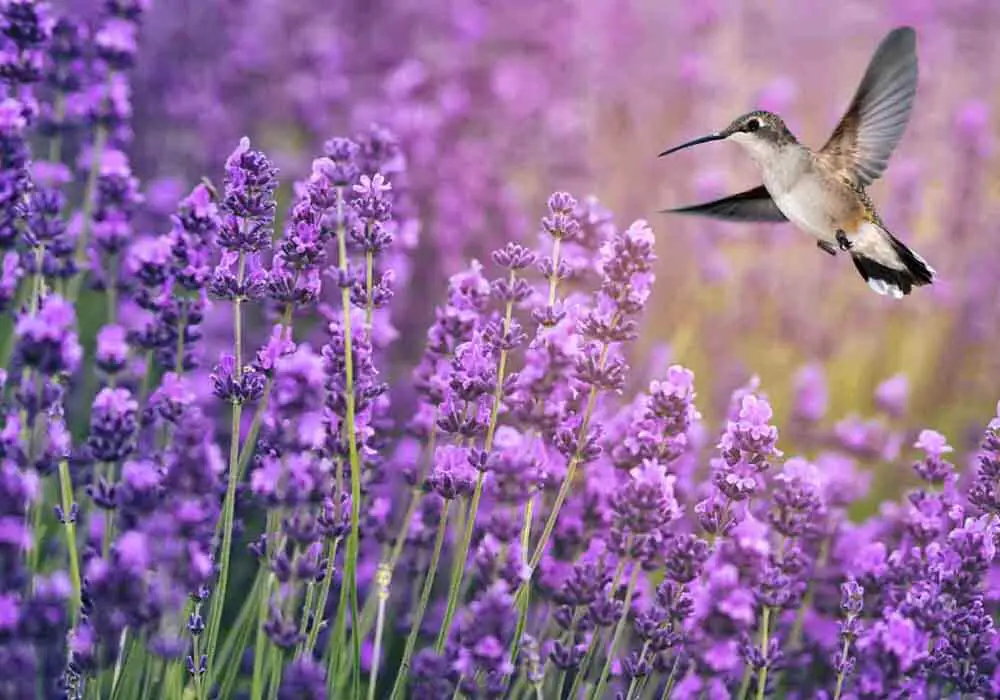How To Attract Hummingbirds
to Your Garden or Yard
Hummingbirds are attractive, fascinating little creatures that are a joy to have as guests in the garden. One can spend hours watching them flutter about, flitting from one flower to the next and frolicking in bird baths and fountains. So, how to attract hummingbirds to your garden or yard?
You can attract hummingbirds to your garden by filling it with flowers, insects, perches, and water. Encourage a healthy ecosystem in your garden by avoiding harmful pesticides. Stationing bird baths, fountains, and feeders strategically in your garden will entice hummingbirds to fly over.
In this article, we will talk about how to attract hummingbirds to your garden. You’ll also learn a thing or two about the best feeders, bird baths, and fountains that can make your garden an ideal location for these cute little birds. Let’s start!

What Plants and Flowers Attract Hummingbirds?
Hummingbirds are exceptionally equipped for feeding on flowers as they have long bills and grooved tongues perfect for poking the nectar within. Sweet nectar, which makes up about 90% of their diet, is an excellent energy source for these busy birds.
You can attract hummingbirds to your garden by offering them plants and flowers like sage, bee balm, foxglove, iris, petunia, cardinal flower, verbena, impatiens, and trumpet honeysuckle. The trick is to scatter these irresistible treats across your garden and hang some from hanging baskets.
Hummingbirds have an affinity for red or orange flowers, so make sure to have a lot of them in your garden. Choose various plants with different blooming durations and periods, so your garden will always be festooned with flowers. Avoid using pesticides, especially those laced with chemicals, since these can harm hummingbirds and easily drive them away.
You can also make your garden bird-friendly for nesting hummingbirds. They like the protective cover offered by shrubs and trees, so make sure to have a lot of these planted around the edges of your garden.
As for perches on which they can rest, nap, or observe their surroundings, have some scattered about in open areas of your garden and some hidden in clusters of plants and trees. You can use sturdy sticks and ready-to-use bird perches. You can also prune a couple of smaller tree branches and vines to attract hummingbirds to your garden.
What Is the Best Food To Attract Hummingbirds?
Do not be fooled by the hummingbird’s diminutive stature. Despite being among the smallest birds on the planet, they have voracious appetites to sustain their quick metabolism and remarkable capacity to travel long distances.
In fact, hummingbirds are one of the most powerful migrants in the bird kingdom. They are documented to be capable of undertaking the longest migrations in the world based on the distance traveled in proportion to body size. To sustain such high energy levels, hummingbirds eat roughly every 15 minutes, usually by flitting between 1,000–2,000 flowers, each day.
Insects are among hummingbirds’ favorite food, especially since they are packed with protein essential for physical well-being and growing feathers. While hummingbirds are excellent aerial hunters, providing them with accessible food sources will certainly lure them in.
Maintain a robust ecosystem in your garden by avoiding the use of pesticides. This is to ensure the presence of insects among your flowers, shrubs, and trees, particularly those that
aid in pollination. Spiders are also crucial allies since their webs attract and trap insects that hummingbirds can eat.
Another strategy is to hang a basket filled with overripe fruits and fruit peels around your garden, particularly where you notice higher hummingbird activity. These will undoubtedly attract fruit flies, in turn attracting ravenous hummingbirds that won’t be able to resist the temptation of easily accessible food.

Wanting to be thourough on the topic of feeding Hummingbirds, I wrote a helpful article on what you should and should not feed a Hummingbird...it's a must read!
What Kind of Feeder Attracts Hummingbirds?
Feeders are innovative ways to attract hummingbirds to your garden while ensuring they get the nutrition they need from nectar. Setting up feeders is especially useful during the migration season (spring and autumn), when migratory hummingbirds need extra sources of energy and sustenance.
Red or orange-colored feeders are most attractive to hummingbirds. These birds won’t hesitate to fly and perch off red-colored feeders as long as they’re strategically placed and packed with fresh sugar water.
Fill your feeders with homemade nectar (sugar water) for the hungry hummingbirds. Do not use honey, artificial sweeteners, or food dyes since these can harm the birds. Remember to replace the sugar water with a fresh batch every 3 days or so to prevent the sugar solution from getting cloudy.
Cleaning the feeders thoroughly with warm water before you replace the sugar water will help prevent mold growth.
Here is a simple recipe for hummingbirds' sugar water:
- Fill a jar with 4 cups of clean water.
- Add 1 cup of refined white sugar.
- Mix until the sugar is completely dissolved.
- Store any remaining sugar water in the fridge for future use.
NOTE: Do not use any other sweetener (like molasses, honey, brown sugar) use only white sugar. how to attract hummingbirds to your garden or yard
Below are tips on how to attract hummingbirds to your garden usin feeders...
Distance Is Key

Position your feeders in strategic locations throughout your garden. It would be best to hang several feeders quite a distance away from each other so the birds won’t see one another.
Since hummingbirds have a tendency to be fiercely territorial, setting up feeders too close to each other might trigger scuffles, and you don’t want that.
Remember that hummingbirds do not like sharing their food. This natural instinct stems from the fact that nectars from flowers always come in limited quantities and only within a fixed period. Though they may be considered smart, hummingbirds cannot distinguish that feeders function differently from flowers.
If the feeders aren’t spaced appropriately, a hummingbird or two might claim dominance over all these food sources. They will chase away any other hummingbirds curious or brave enough to approach. You’ll be much more successful attracting more hummingbirds to your garden with small feeders spread out rather than having just 1 or 2 big ones.
The eWonlife Humming Bird Feeder (Amazon.com) comes as a set of two saucers, each with five feeding ports. The feeder’s lightweight, saucer-shaped design makes it easy to clean, while the hanging hooks allow for easy installation anywhere in your garden. It’s also nice that the feeder is waterproof and red-colored to attract hummingbirds.
Keep Them in the Shadows
It's simple — Look for areas within your garden that enjoy dappled sunshine. These are the best places for hummingbird feeders to help minimize mold growth. Moreover, areas with dappled sunlight provide the right balance of light and shade, ideal for rest and relaxation.
Direct sunshine makes the feeders too warm and affects the freshness of sugar water, especially from noon and on particularly hot days. Furthermore, hummingbirds might be hesitant to approach feeders in wide open spaces since these make them feel unsafe and vulnerable.
On the other hand, deeply shaded areas may make the feeders impossible for hummingbirds to spot from the air. You’ll know that you need to move your feeders to more visible locations if they have gone unnoticed after about a week. how to attract hummingbirds to your garden or yard
The MEKKAPRO Outdoor Hummingbird Feeder (Amazon) boasts a glass body that allows you to monitor the nectar and know when to refill. In addition to having a red seal and base, this feeder also comes with five perches to accommodate several hummingbirds.
Cover Should Be Accessible
You can also place your feeders near trees, shrubs, or any place hummingbirds can perch or hide. Since they do not like feeding out in the open, providing them with sufficient cover will allow them to have a place to rest to conserve their energy when they’re done feeding.
Position your feeders about 10–15 feet (3–4.5 m) away from shelter. Great cover also gives them a chance to survey their surroundings. If they like what they see, they will definitely be coming back for more and maybe even claim an exceptionally cozy spot as their home.
If you’re looking for a vibrant feeder to enhance your garden’s aesthetics, you might want to try out the Muse Garden Hummingbird Feeder (Amazon.com), which comes in a rich blend of colors. The feeder is made of hand-blown glass and is specifically designed to attract hummingbirds. It’s also convenient that the feeder is equipped with tiny perches where hummingbirds can rest while feeding.
Squirrels Out!
But what about those furry, bushy-tailed rodents that seem to love these bird feeders just as much as the hummingbirds? They bend over backward (sometimes, quite literally) just to get to the sweet treats. Aside from feeding on the sugary water themselves, squirrels also scare away the hummingbirds. Is there a way to keep them at bay?
The best way to keep squirrels and other furry climbers away from your hummingbird feeders is by installing hanging baffles above them. Baffles are closed off at the top, so when squirrels succeed in somehow climbing up to the feeder, they’re left baffled (again, quite literally) because they have nowhere to go. You can choose from cylindrical, cone-shaped, or dome-shaped baffles to suit your feeders’ needs.
For a unique, vintage look, you can try out the Billion Sky Hummingbird Feeder (Amazon.com). Despite being made of glass, the unique feeder is sturdy and will not easily be toppled over by curious larger birds or plucky rodents.
As a good rule of thumb, you should not coat poles, hooks, or chains with grease or oil. This may make it too slippery for squirrels to climb, but they can also put hummingbirds in danger. Your valued feathered friends might accidentally bump into these greasy contraptions and inadvertently coat their feathers. Oily feathers will impair their flight and may be disastrous for them.

Attracting Hummingbirds using feeders is one thing, but what are the best feeders to use?? I've written a dedicated article that reviews Feeders That Attract Hummingbirds The Most...bon appe'tit little birds!
What Kind of Birdbaths Do Hummingbirds Like?
Water is also a great way to attract these beautiful winged creatures to your garden.
Hummingbirds love to bathe in water fountains, bird baths, shallow pools, and even in droplets that have collected on leaves. You can also install misting devices around your garden, which benefit both your plants and the hummingbirds.
Station attractive water fountains and bird baths in various parts of your garden, particularly in places near perches, trees, shrubs, or feeders. This way, hummingbirds that have stopped to rest or feed will be enticed to extend their stay.
The nearby perches will also give them a chance to preen their feathers, which is a truly fantastic activity to observe. Watching these beautiful birds play in the water is also fascinating.
You can hang a simple bird bath like the WUFEILY Hanging Bird Bath (Amazon.com), which is easy to set up on branches, perches, or even by your porch. This attractive outdoor glass bath is made of colored glass and decked with attractive floral designs to grab the attention of inquisitive hummingbirds.
And for extra comfort on those chilly days, you can try out the Hugeneroy Heated Bird Bath (Amazon.com), as it provides extra warmth and comfort for hummingbirds. You can position this heated bird bath near your porch or walls where they can be hooked up to a power source.
Alternatively, the AISITIN 2.5W Solar Bird Bath Pump (Amazon.com) can also work well for hummingbirds. Simply look for a basin deep enough to completely submerge this device. It has suction cups underneath so it won’t float on water, and comes with 6 different spray settings to keep hummingbirds entertained. Make sure to place it where it gets enough sunshine throughout the day.
But if you’re more for that traditional garden look, the Sunnydaze Dove 3 Tier Water Fountain (Amazon.com) can make the perfect fit. Hummingbirds will love getting their feathers wet under the little waterfalls and splashing about in the shallow pools. Station this in a highly visible area in your garden, perhaps near some flower bushes, to make it extra irresistible for feeding hummingbirds.

Hummingbirds love a good bath! Yet, not all birdbaths are created equal. On this helpful page of mine I review the birdbaths Hummingbirds love. Before you know it, you'll have a Hummingbird bath party in your garden!
How To Attract Hummingbirds To Your Garden Or Yard...Final Thoughts
Hummingbirds are feisty, curious little creatures that are a joy to behold and mesmerizing to observe. Having them flitting about in your garden is such a treat. That’s why many people spend time fixing up their yards before spring arrives to entice these feathered beauties to stay around and play.
Convincing hummingbirds that your garden is a safe and fun place is easy. Offer items, food, and attractions they love. You can never go wrong by providing an abundance of food, exciting bird baths (and fountains) for playtime, and strategic places for perching, preening, and nesting.
Back To TOP Of How To Attract Hummingbirds To
Your Garden Or Yard Page

About the Author...
Richard Worden, a dedicated bird lover for over 20 years, I love to share my in-depth knowledge and passion for birds. Read more About Me and my expertise in this field.
- We Know Birds HOME ›
- Hummingbird Facts and Information ›
- How To Attract Hummingbirds to Your Garden or Yard
